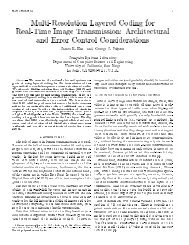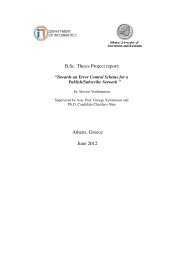In Network Processing and Data Aggregation in
In Network Processing and Data Aggregation in
In Network Processing and Data Aggregation in
Create successful ePaper yourself
Turn your PDF publications into a flip-book with our unique Google optimized e-Paper software.
function SE() to translate its local synopsis to the f<strong>in</strong>al answer. The cont<strong>in</strong>uous querydef<strong>in</strong>es the desired period between successive answers, as well as the overall duration ofthe query.Double-Count<strong>in</strong>g ProblemAs we have already mentioned, multipath techniques usually double count the samevalues because of the multiple parents of some nodes. Nevertheless, Synopsis diffusionavoids double-count<strong>in</strong>g through the use of order <strong>and</strong> duplicate-<strong>in</strong>sensitive (ODI)synopses that compactly summarize <strong>in</strong>termediate results dur<strong>in</strong>g <strong>in</strong>-network aggregation.Ma<strong>in</strong> drawbackThe total number of massages that are exchanged between the sensor nodes dur<strong>in</strong>g theaggregation phase is a lot higher compar<strong>in</strong>g to that of a simple tree-based approach.Therefore, the “synopsis diffusion” approach is more robust-oriented that energyefficient.3.4.3 Distributed Localized AlgorithmsUs<strong>in</strong>g Distributed Estimation [19]Boulis et. al <strong>in</strong> [19] proposed a distributed localized algorithm that explores theenergy/accuracy subspace for the periodic aggregation doma<strong>in</strong>. They firstly separated the<strong>in</strong>-network process<strong>in</strong>g algorithms <strong>in</strong> two different types.<strong>Process<strong>in</strong>g</strong> Type-I: <strong>In</strong>cludes all the “snapshot aggregation” solutions that calculate anaggregate by simply comb<strong>in</strong><strong>in</strong>g the values at multiple <strong>in</strong>termediate nodes until the f<strong>in</strong>alvalue reaches the s<strong>in</strong>k (this type <strong>in</strong>cludes all the approaches that have been reviewed sofar).<strong>Process<strong>in</strong>g</strong> Type-2: <strong>In</strong>cludes the approaches that take <strong>in</strong>to account that the sensedvalues are just approximations of the real ones <strong>and</strong> moreover, they do not try to calculatean aggregate but they rather attempt to achieve a “good” estimation of it.








